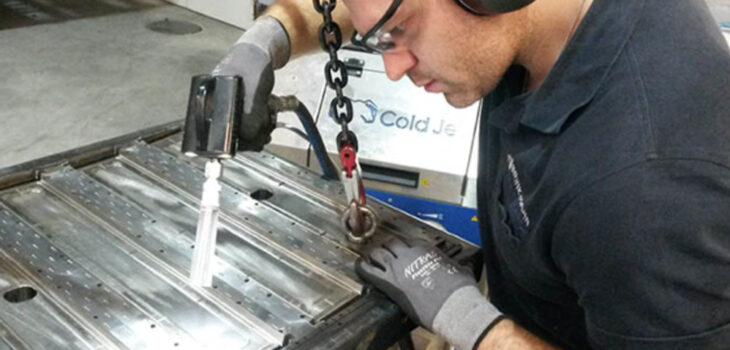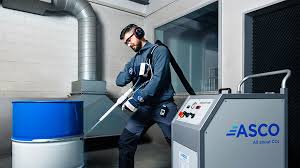 Business
Business
Dry Ice Blasting for Precision Cleaning in Industrial Settings
- by raza
Dry Ice Blasting for Precision Industrial Cleaning
Cleaning is more than just aesthetics in industrial settings; it’s essential for product quality, safety, equipment operation, and regulatory compliance. However, cleaning in these settings presents difficulties due to sensitive equipment, constrained manufacturing schedules, and the requirement to refrain from using water, chemicals, or abrasive methods. Presenting dry ice blasting, a potent and accurate cleaning technique that is revolutionizing industrial maintenance. Let’s examine why it’s quickly becoming as the go-to option for precise cleaning.
What Is Dry Ice Blasting?
Solid carbon dioxide (CO₂) pellets or shavings are used as the cleaning medium in dry ice blasting, an environmentally benign, non-abrasive, and non-toxic cleaning method. Compressed air is used to propel these dry ice particles at a high speed. The dry ice lifts away dirt, grease, impurities, and residues without causing surface damage when it comes into touch with another material.
Its lack of chemicals or water is what really sets it apart, making it perfect for delicate machinery and precision parts used in a variety of sectors.
How It Works for Precision Cleaning
Dry ice blasting relies on three primary cleaning forces:
1. Kinetic Energy
High-velocity dry ice pellets hit the surface with significant force, breaking the bond between the contaminant and the substrate.
2. Thermal Shock
Dry ice is extremely cold (-78.5°C or -109.3°F). When it contacts the warmer surface, it causes contaminants to contract and crack due to thermal shock, loosening them further.
3. Sublimation and Expansion
Upon impact, the dry ice sublimates instantly. This rapid phase change creates a microscopic explosion, lifting particles away without leaving residue or introducing moisture.
This triple-action process allows for precise and effective cleaning, even in hard-to-reach areas or intricate components.
Why Dry Ice Blasting Is Ideal for Precision Cleaning
Precision cleaning demands a method that can thoroughly clean without damaging delicate components. Dry ice blasting excels in this area due to several core benefits:
– Non-Abrasive Cleaning
Dry ice doesn’t erode surfaces the way sandblasting or scraping does. It is ideal for sectors including electronics, medical manufacturing, and aerospace since it is mild enough for sensors, electronics, and polished metal components.
– No Secondary Waste
Since dry ice evaporates on contact, there’s no blasting media or liquid residue left behind. Only the dislodged contaminants remain, reducing cleanup time and disposal concerns.
– Dry and Chemical-Free
Dry ice blasting requires no water or solvents, making it safe for equipment that’s sensitive to moisture or chemical exposure. This is critical in electrical systems or medical device production.
– Cleans In-Place
Dry ice blasting often allows for clean-in-place (CIP) operations. Machines don’t need to be disassembled, which saves time and avoids reassembly risks.
– Eco-Friendly and Compliant
With no toxic byproducts and CO₂ that’s often recycled from industrial sources, it supports sustainability goals and environmental compliance.
Industrial Applications for Precision Cleaning
Dry ice blasting is used across various industries where precision and reliability are paramount:
1. Aerospace and Aviation
Cleans aircraft engine parts, avionics, and composite materials without damaging sensitive surfaces or electronics.
2. Medical and Pharmaceutical
Used to clean manufacturing equipment for medical devices, surgical tools, and sterile production environments, where even microscopic contaminants are unacceptable.
3. Semiconductor and Electronics
Effectively removes dust, flux residues, and oils from circuit boards and cleanroom equipment, without creating static or leaving residues.
4. Automotive and Plastics
Removes mold release agents, resins, and carbon buildup from molds and production lines, preserving tooling precision and surface finishes.
5. Printing and Packaging
Cleans ink, adhesives, and paper dust from presses and rollers, ensuring consistent quality and reducing machine wear.
Dry ice blasting is clearly suited for precision applications, especially where moisture or abrasion are unacceptable.
Equipment and Safety Considerations
– The Equipment
A dry ice blasting system typically includes:
- A dry ice storage hopper
- An air compressor
- A blasting gun and interchangeable nozzles
- A hose system for air and pellet delivery
Advanced models offer variable pressure and flow settings for even greater precision.
– Safety Precautions
Though dry ice blasting is safe when used correctly, operators must follow best practices:
- Use personal protective equipment (PPE) like gloves and eye protection.
- Ensure proper ventilation, as CO₂ gas can displace oxygen in enclosed areas.
- Train staff in correct machine use and maintenance.
Limitations to Be Aware Of
While dry ice blasting has numerous advantages, it’s not suitable for every scenario:
- Initial Equipment Cost: Machines can be costly, though long-term savings offset this.
- Sublimation Loss: Dry ice must be used quickly to avoid loss due to sublimation.
- Material Suitability: Extremely brittle or porous materials may not be ideal.
Conclusion
By providing a dry, clean, and non-abrasive way to uphold the highest standards of cleanliness, dry ice blasting has completely changed the definition of precision industrial cleaning. It is the top option for sectors that need precision, efficiency, and care because of its efficacy in delicate settings, as well as its advantages for the environment and little downtime.
Dry ice blasting stands out as a great technology that satisfies today’s demanding needs as organizations continue to look for dependable, efficient, and sustainable cleaning solutions. Dry ice blasting guarantees accuracy without sacrificing quality, whether you’re servicing electronics, aerospace parts, or sophisticated medical equipment.









